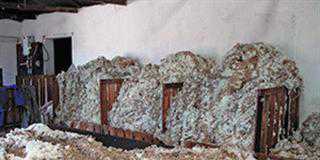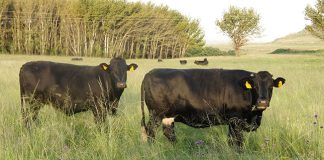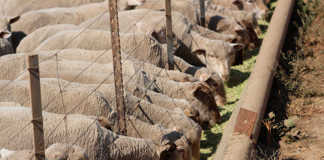South Africa has always produced a high quality Merino wool clip in demand internationally. Currently, this type of wool is in short supply, partly because production has declined in Australia, which produces most of the world’s Merino wool, and partly because of increased demand from China. The result is that Merino wool is realising good prices and wool sheep farming has become profitable – provided good farming methods are followed.
The first step towards profitability is to run the right type of Merino for your climate and nutrition conditions. Before you buy a ram, get advice from established Merino breeders in your area. Ask them how much wool their sheep carry and in which micron range (usually from about 18 microns to 23 microns) their wool falls. The next step is to look after your flock, keeping the animals healthy and in good condition so that they can produce and reproduce. As far as possible, fleeces need to be kept free of dust, seeds and chemicals.
Shearing
The final step is shearing and classing the fleeces according to industry standards. Since clip preparation is an important link in the quality chain between the wool producers and wool processors, it provides a gap for value adding before the wool leaves the farm. Poor shearing, classing or packing of wool can lead to unnecessary losses. Sheep should be shorn on a clean concrete or wood floor at between eight and 12 months of wool growth. The shearers should first remove the locks (dung- and urine-stained wool) and bellies and short wool from the lower legs and faces.
Classing
A shorn fleece is cast onto a slatted classing table, and the remaining shorter and dirty pieces are removed. The aim is to class (or divide) the wool into uniform groups, based on characteristics that are important to processors. This involves assessing the fleece according to fineness, length, tensile strength, clean yield and general appearance, and placing each different group in a separate bin.
The various groups are then separately pressed into bales weighing about 170kg each, closed with not more than nine metal hooks, and marked according to the length and fineness of the content. For example, a bale of good fleece wool with staple averaging 65mm in length and with an estimated count of between 20 and 22 microns will be labelled as BM. Longer, finer lines might carry the AF symbol, while shorter, stronger types might be marked CS. There’s a symbol for just about every type of wool.
Tips
- Don’t let your pure Merino flock mix with other breeds, and don’t mix cross-bred or coarser wool with your pure Merino clip.
- Ensure that the shearers handle the sheep properly, don’t cut them and shear them neatly and uniformly.
- Never shear and bale wool that feels wet.
- Only bale wool in approved nylon packs and definitely not in old fertiliser, seed or feed bags. These will contaminate the wool with plastic fibres.
- Keep foreign objects, that could end up in the bales and contaminate your clip, out of the shearing shed. These include baling twine, pieces of wire, spanners and cigarette butts. Such contaminants can seriously damage processing machinery and lead to claims for losses.
- Mark the bales only with approved marking ink or pens.
Talking wool
- Wool: Different from hair or fur, because it’s soft, dense, curly (crimped), elastic and grows in clusters (staples). These characteristics make it easier to ‘process’ wool into good quality textiles – and are why the commodity has attained and retained popularity over centuries. Merino wool is sought after because of its fineness, among other things.
- Greasy wool: Wool straight off the sheep.
- Fleece: The wool covering of a single sheep.
- Wool clip: The total amount of wool shorn from a particular flock or the total amount from a certain region.
- Micron: Unit of measurement of the diameter of wool fibre (µ). A micron is 0.001mm. The lower the micron, the finer the fibre. Fibre diameter is the most important factor in determining wool’s value.
- Tensile strength: The resistance of a fibre to a force trying to tear it apart. When wool becomes too fine (about 15µ) there’s a danger of losing tensile strength. This usually occurs under poor feeding conditions, such as during a drought. It is one of the reasons why wool growers must be careful to produce the type of wool that suits their farm environment.
A handy booklet, Code of Practice for Clip Preparation, can be ordered from Cape Wools in Port Elizabeth. Contact Cape Wools on 041 484 4301 or email [email protected].













